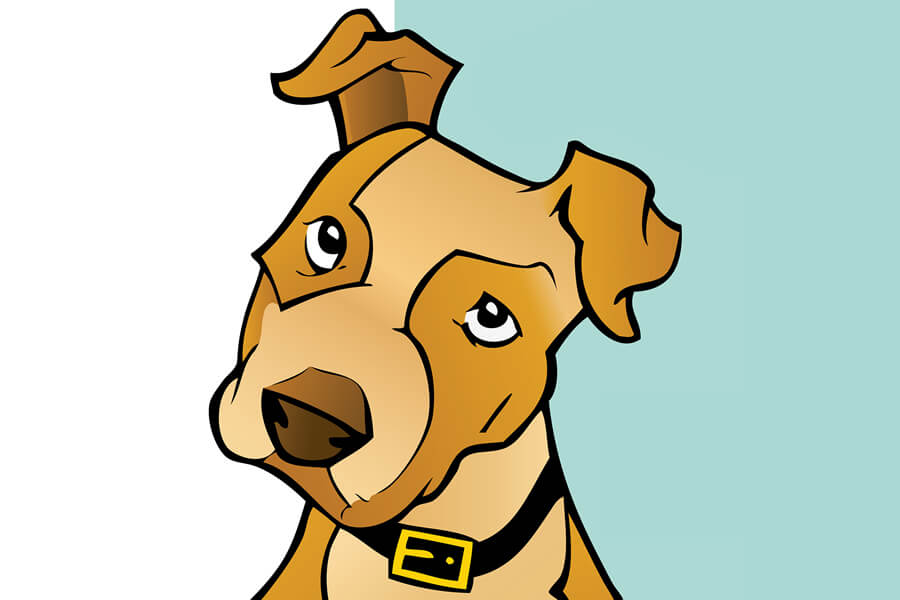
What am I thinking?
What exactly do dogs think? About us. About the world. About themselves. Duncan Foster investigates the latest developments in human understanding of the canine mind.
In a famous New Yorker magazine cartoon, published in 1993 and penned by Peter Steiner, a dog is shown sitting in front of a computer screen. With one paw resting on the keyboard, he turns to a fellow hound, who has adopted a customarily supine and canine position, gazing up in awe at anyone capable of using a swivel chair (let alone operating a computer). The dog at the computer addresses his less well-informed, his less online savvy friend with words of conspiratorial advice: “On the internet, nobody knows you’re a dog”. Who can guess at his enterprise? Scamming, beguiling, fooling, passing on mad political opinions, posting incendiary opinions on the lacklustre performance of his master’s favourite team, applying for a bank account, perusing house prices?
OK, it was a laugh at the expense, not of dogs, but of people. See how you can dupe electronically. See how you can recreate yourself in anonymity.
And see how you can seem smarter than your appearance would suggest were someone to bump into you in the street or the park, weeing up against a lamppost or a tree, we might add. But though the satire was directed at the emerging, amorphous online universe in which it is possible to pretend to a wholly new identity, the cartoon also raises another serious question – for pet owners, at least. Just how much do dogs actually connect with our world, just how clever are they? Particularly when it comes to dealing with human beings, those ancestral companions in whose caves and houses, for millennia, they have snuggled
warmly beside fires and central heating systems; at whose campsite gatherings and at whose rather nice pine kitchen tables they have snaffled treats; at whose sides they have hunted in woods and walked down Acacia Avenue; at whose commands they have shepherded sheep with a keenly obedient ear and have failed to return with an obtusely disobedient ear when repeatedly told to do so on a country stroll. Just what do dogs think, and how good are they at it?
I remember once watching an episode of the US sitcom, Frasier. In it, Martin Crane, Frasier’s father, unwelcome house guest and owner of Eddie, a frisky and hard-staring Jack Russell Terrier, is engaged in debate, mostly with himself, as to the various levels of intelligence of various breeds of dog. The measure of canine IQ, plucked from a popular magazine, involved a specific test, its accomplishment gauged by the time it took for its completion (shaking off a tea towel seemed to be the main requirement). Utterly convinced that Eddie is the nimblest dog in the world mentally, Martin is dismayed at his pet’s inability to outperform the times recorded (on average) by Border Collies, Dalmatians, German Shepherds and, the final humiliation, Poodles.
Every dog owner would recognise the sentiment: of course, my dog is smart; he or she must be because they understand me. And dogs do. They are incredibly adept at appraising people (as we shall discover in later issues). But how do dogs’ minds work?
Scan for intelligent life
A black Terrier-cross, called Callie and belonging to Gregory Berns, a neuroeconomics professor at Emory University in Georgia in the US, saunters nonchalantly into the interior of an MRI scanner. (Callie is so accustomed to the scanner and the earmuffs she wears to sieve out the noise of the machine, and so encouraged by the fuss made of her by the scientists, that she often leaps up before everyone is ready.) For the next few seconds only – she has been trained, lengthily trained (some eight months) to lie perfectly still – her brain is (safely and harmlessly) scanned while she is flashed hand signals that relate to food and is introduced to familiar scents and glimpses sight of people she knows well. The scan over, she bounds down, tail wagging, to rejoin her human friends and snack on her reward.
The purpose of the exercise was to determine which of Callie’s brain circuits – other dogs took part too – responded when she saw a gesture that meant a treat was imminently on its way. The results? Well, preliminary at the moment. But it seems that the ‘there’s some food waiting’ hand signals set fire to neural systems in the caudate nucleus, a part of the brain associated with the anticipation of a reward. “In the study being reviewed, we presented smells from other humans and dogs from the dog’s household next to strange human and dog smells,” said Professor Berns. “It’s clear from the scans that they’re identifying the familiar human. And we’re seeing activation in the same reward pathways as the hand signal and food.”
Professor Berns plans further trials in which his team will look at how dogs, as measured by the bio-chemical activity in their brains, react not just to the promise of a feed but also to the level of their empathy for their owners. Also on the agenda is how dogs process owners’ voices, and the commands and the conversations they have with them.
The research is tentative at the moment. There are still endless questions to be answered as to how dogs think and react to the world, and to their relationships with people. “How do dogs distinguish among the humans they know; is it by sight or smell?” asks Professor Berns. “What meaning does our language have to them? How do their minds represent humans and other animals, including other dogs?” He then poses an even deeper question. The study of canine thinking, he suggests, given the intertwining, the co-dependency of our development, ultimately brings us back to ourselves: “Because humans, in effect, created dogs through domestication, the canine mind reflects back to us how we see ourselves
through the eyes, ears, and noses of another species.”
Heavy stuff. And another difficult, though not unconnected, question too. Do we, as pet owners, really, really want to know whether that slobbering, wet-nosed greeting at the door after a terrible day at work, that proffered paw after a piece of upsetting news, that wagged tail, that doleful gaze, that nudge against the leg, is really just a Pavlovian act, a demand for a treat. Or a genuine act of sympathy and understanding, however inarticulately expressed. Do we actually want to know what our dogs are thinking? I guess that my mind may never be changed, no matter the objectivity of our wonderful neuroscientists. As I look down at the sleeping form of Sadie, my now sleeping and snorting Labrador, I am as convinced that as much as I love her so she loves me; that her emotional inner world is as complex, as troubled, as uplifted as mine. That may be because I am me, a human being, and not her, a slobbering Labrador. But what is love other than a bridge over chasms? Then again, suppose it turns out fine? Suppose those future MRI scans show, in their regimented, equational, inevitable, unarguable way, that – forget the food, the shelter, the central heating – dogs do care for us, that they do love us. That in their minds’ eyes we are special.
Now wouldn’t that be a thing.
You can read more articles like this one in the latest edition of Thame Out.
 Thame Out The complimentary magazine for the Thame area
Thame Out The complimentary magazine for the Thame area

